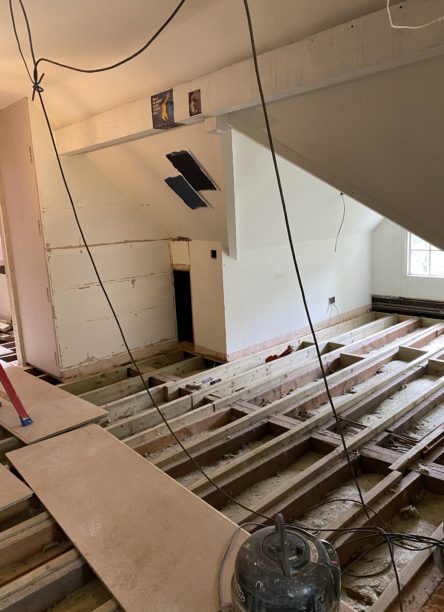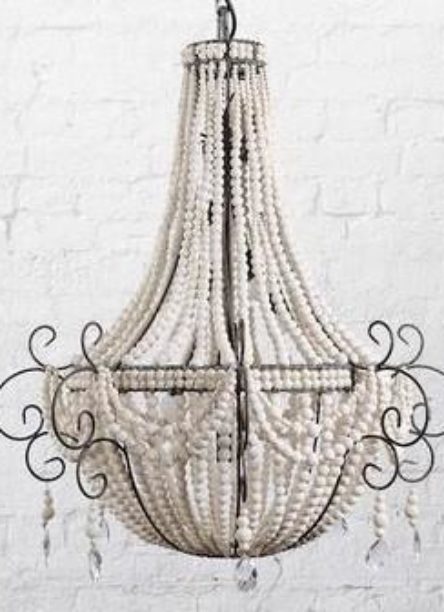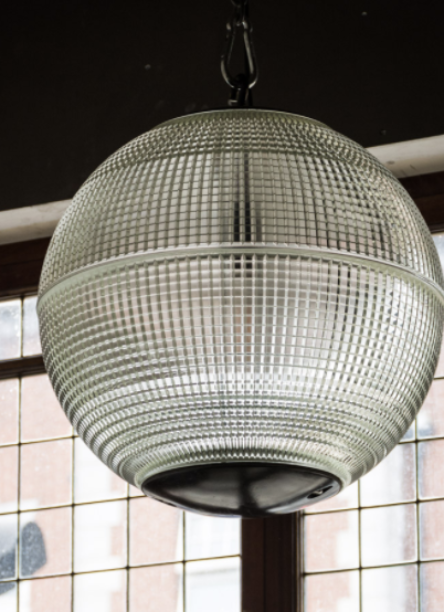
current project
The building works are happening at the moment. There are many things I’ve set out to do, including changing room configurations slightly, and updating the bathrooms and kitchen. And there are issues that have cropped up, like fixing very old electric cabling that was not well made and is just plain illegal now. The roof, boilers and fuseboxes also all need to be looked at.
As the Interior Designer, but also as project manager for this refurbishment, I need to wear many hats when speaking to the client – builder included. Once we have moved off the structural works, we will go on to the kitchen and bathrooms as they take longer to supply and are essential for builders to incorporate. Bespoke items also need to be designed and quoted early on to find the best supplier for each item or to entrust the construction company themselves with the joinery.

uneven flooring needing to be fixed
One item that has come smack in the middle of the project is lighting. I have a design in mind, the client is on board, and all the pressing ‘To Do’ points up to now have been taken care of. Although furniture, carpets and rugs as well as accessories still need to be decided on, I have researched and thought about them all. So, I can now focus on lighting.
Lighting is an area where both form and function are essential. I want a light fitting that does the job, but that is also a decorative item which looks good. I have never been a fan of putting downlights everywhere and saying ‘est voila’! However, I do concede that downlights can certainly help create different moods in a room and are sometimes essential to support the main pendant. As you probably surmised if you’ve read my other Journal posts, given our studio philosophy, I love antiques. Unfortunately the ones I love are usually not ones emitting the highest amount of lumens!

Decorative lighting
Although I believe in a perfectly imperfect design concept, I want the finished work to be excellent in every regard, so I seek out specialist expertise where I need it. One area I like to get guidance is lighting, and for that, I turn to Rebecca Weir from light.iQ. To get things rolling on this project, I worked on a lighting plan myself, deciding where I wanted the pendant, wall lights and downlights. Then I had a 2-hour session with Rebecca (which I highly recommend), where she cast her eyes over my general ideas and made suggestions where I needed to create more or less light.
If you’re not versed in lighting, you might think it’s perfectly adequate to go into a room and just switch on a light. When you look deeper into the lighting options, however, it is ideal to have your main lights dimmable and then maybe a second 5amp circuit for lamps. These two options together enable you to create different scenes and lighting moods, really enhancing the atmosphere in the room for different occasions. It’s important to think about these elements before starting to build, because the electrician will need the information when they’re carrying out the core works around the house.

antique lighting
After the session with Rebecca, I presented the ideas to the client. When the client had signed off on them, I was able to get down to choosing the fittings and getting all the fact sheets together. Once I have done that, I will go back to Rebecca and recheck whether the mix of lights will bring the intended effect. This whole process makes me go through each item so many times that the end result is sure to (not blind!) be mesmerising 🙂
